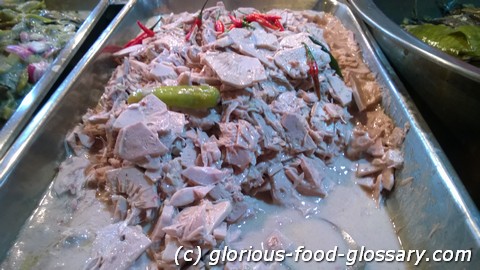Deutsch: Kamansi in Kokosmilch / Español: Kamansi en leche de coco / Português: Kamansi em leite de coco / Français: Kamansi Au lait de coco / Italiano: Kamansi nel latte di cocco
Ginataang Kamansi in the food context refers to a traditional Filipino dish made from breadnut (kamansi), which is cooked in coconut milk (gata). Kamansi, known scientifically as Artocarpus camansi, is closely related to breadfruit and jackfruit, and is valued for its starchy, edible seeds and flesh. This dish is a part of the broader category of "Ginataan" recipes in Filipino cuisine, which involves cooking various ingredients in coconut milk, often resulting in creamy, rich, and flavorful dishes.
Description
The essence of Ginataang Kamansi lies in its combination of the subtle, slightly sweet flavor of kamansi with the rich creaminess of coconut milk. The dish may also include spices, shrimp paste (bagoong), chili, and sometimes pork or seafood to add depth and complexity to the flavor. Kamansi is appreciated for its meaty texture, making it a popular meat substitute in vegetarian diets within the Philippines. The dish is typically served as a main course, often accompanied by rice to Complement the creamy sauce.
Application Areas
Ginataang Kamansi is predominantly consumed in:
- Home Cooking: As a traditional and nourishing meal that showcases the local produce.
- Special Occasions: Served during gatherings and celebrations as part of a larger feast.
- Vegetarian and Vegan Diets: As a plant-based option that offers a satisfying, meat-like texture.
Well-Known Examples
Within the variety of ginataan dishes, Ginataang Kamansi stands out for utilizing the breadnut, but other popular ginataan dishes include:
- Ginataang Gulay: A vegetable stew in coconut milk, including squash, string beans, and eggplant.
- Ginataang Langka: Young jackfruit cooked in coconut milk, often with pork or shrimp.
- Ginataang Manok: Chicken cooked in coconut milk, showcasing how versatile the ginataan cooking method is with different main ingredients.
Recipes
A simple recipe for Ginataang Kamansi involves:
-
Ingredients:
- Kamansi (breadnut), peeled and chopped
- Coconut milk
- Shrimp paste (optional for seasoning)
- Chili peppers (optional for heat)
- Salt and pepper to taste
- Optional ingredients: pork, shrimp, or fish for added protein
-
Preparation:
Treatment and Risks
Ginataang Kamansi is considered a nutritious dish, with kamansi providing dietary fiber, vitamins, and minerals, and coconut milk contributing healthy fats. However, the calorie content can be high due to the coconut milk, so moderation is advised, especially for those monitoring their calorie intake.
Similar Terms or Synonyms
- Breadnut in Coconut Milk
- Kamansi Stew
Summary
Ginataang Kamansi is a cherished Filipino dish that highlights the breadnut's potential as a delicious and nutritious ingredient. Cooked in rich coconut milk and often flavored with shrimp paste and chili, it represents the comfort and complexity of Filipino cuisine's use of local ingredients. This dish not only provides a taste of the Philippines' culinary diversity but also offers a hearty and satisfying meal that can be enjoyed by everyone.
--
Kamansi , is one of the food items in the Philippines which is categorized as vegetable. The flesh of the fruit is usually chopped or sliced into small bite size pieces then cooked as a vegetable mostly in coconut milk (Gata): Kamansi is called Seeded Breadnut in the Philippines. Its scientific name is ""Artocarpus camansi"" In other parts of the country, Kamansi is also called Pakak, Dalungyan, Ogob and Antipolo. It has a sharp skin/rind very much like Jackfruit of Langka aand has soft seeds. Kamansi is always interchanged with Rimas, which is its close relative. Rimas though have soft skin/rind andit has no seeds. Kamansi is believed to be originated from Papua, New Guinea, Indonesia and the Philippines

Related Articles to the term 'Ginataang Kamansi' | |
| 'Ginataang Labong' | ■■■■■■■■■■ |
| Ginataang Labong in the food context refers to a traditional Filipino dish made from bamboo shoots (labong) . . . Read More | |
| 'Kamansi' | ■■■■■■■■■■ |
| Kamansi, also known as breadnut or seeds of the Maya breadnut tree, is a tropical fruit closely related . . . Read More | |
| 'Albay' | ■■■■■■■■■■ |
| Albay is a province in the Bicol Region of the Philippines, renowned for its rich culinary heritage that . . . Read More | |
| 'Marinduque' | ■■■■■■■■■■ |
| Marinduque is a province in the Philippines known for its unique and traditional cuisine. The food culture . . . Read More | |
| 'Bilo Bilo' | ■■■■■■■■■ |
| Bilo Bilo is the Filipino term for glutinous rice balls made from grounded glutinous rice and formed . . . Read More | |
| 'Ginataang Papaya' | ■■■■■■■■■ |
| Ginataang Papaya in the food context refers to a traditional Filipino dish where unripe papaya is cooked . . . Read More | |
| 'Ginataang Santol at Hipon' | ■■■■■■■■■ |
| Ginataang Santol at Hipon in the food context refers to a traditional Filipino dish that combines santol . . . Read More | |
| 'Coconut' | ■■■■■■■■■ |
| Coconut: The coconut is the fruit of the coconut palm (also, cocoanut), Cocos nucifera, is a member of . . . Read More | |
| 'Lechong Liempo' | ■■■■■■■■■ |
| Lechong Liempo in the food context refers to a Filipino dish that consists of roasted or grilled pork . . . Read More | |
| 'Trotter' | ■■■■■■■■■ |
| Trotter refers to the foot of a pig, cow, or sheep, used in cooking various traditional dishes around . . . Read More | |
